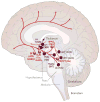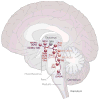Wake-sleep circuitry: an overview
- PMID: 28577468
- PMCID: PMC5531075
- DOI: 10.1016/j.conb.2017.03.021
Wake-sleep circuitry: an overview
Abstract
Although earlier models of brain circuitry controlling wake-sleep focused on monaminergic and cholinergic arousal systems, recent evidence indicates that these play mainly a modulatory role, and that the backbone of the wake-sleep regulatory system depends upon fast neurotransmitters, such as glutmate and GABA. We review here recent advances in understanding the role these systems play in controlling sleep and wakefulness.
Copyright © 2017 Elsevier Ltd. All rights reserved.
Figures


References
-
- Von Economo C. Sleep as a problem of localization. J Nerv Ment Dis. 1930;71:249–259.
-
- Saper CB, Scammell TE, Lu J. Hypothalamic regulation of sleep and circadian rhythms. Nature. 2005;437:1257–1263. - PubMed
Publication types
MeSH terms
Grants and funding
LinkOut - more resources
Full Text Sources
Other Literature Sources

